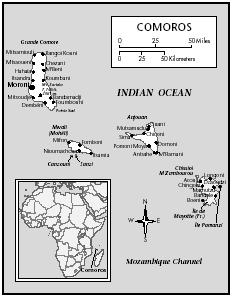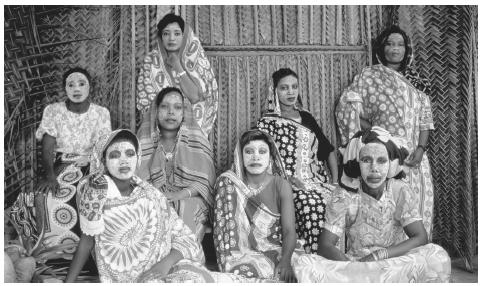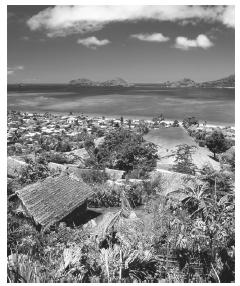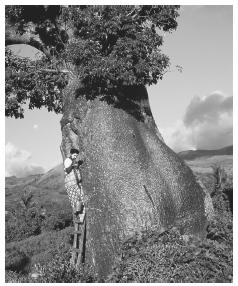Comoros
Culture Name
Comorian
Orientation
Identification. Comorian residents call their Country Masiwa , "the islands," or refer to the individual name of each island. Zisiwa za Komor is a translation of the French words for the country. "Comoro" comes from the Arabic qumr , "the moon" or qamar "whiteness".
Although Comorians practice Sunni Islam of the Chafeite rite, their social organization is matrilineal and residency is matrilocal. Social life is characterized by a widespread system of exchange, which, in turn, creates customary ceremonies and rituals ( aida, shungu ), particularly the Great Weddings ( ndoola nkuu, arusi ). Everyone participates as a member of a given lineage or age group, or as a member of a gender-specific association.
Location and Geography. The Federal Islamic Republic of the Comoros is a group of three volcanic islands totaling 719 square miles (1,862 square kilometers), lying between Africa and Madagascar. The capital, Moroni, is on Ngazidja, which has an active volcano, no rivers, rocky coasts, and beaches. The climate is tropical and humid. Wildlife is rich in rare species, including coelacanths, sea turtles, and lemurs.
Demography. The population of the three islands is estimated at 539,000 in 1999, a number that has doubled in twenty-five years. Forty-five percent of the population is under age fifteen, and only 6 percent is over age sixty. Close to 20 percent of the population, essentially from Ngazidja, has migrated, mostly to France. Many farmers from the overpopulated island of Ndzuani have migrated to Mwali.
Linguistic Affiliation. Comorian is a Bantu language that looks like, but is not related to, Swahili; each island has its own way of speaking it. The language contains many words of Arabic and French origin. All Comorians receive a Koranic education and learn to write their language in Arabic characters. Formal education is given in French.
Symbolism. The national emblem is a green flag (the color of Islam) with a crescent moon and four white stars, that symbolize the four islands (including Mayotte). In 1996, the names of Allah and the Prophet Mohammed were added to the flag. The national anthem is Udzima wa Masiwa ("Island Unity"), and the motto is "Unity, Justice, and Progress."
History and Ethnic Relations
Emergence of the Nation. The islands were colonized by Africans in the eighth century. The presence of Islam is recorded as early as the eleventh century. With the arrival of Muslim Arabs, chiefdoms evolved into sultanates in the fifteenth century. The era of "battling sultans" saw the flourishing of commerce and the slave trade as well as numerous Madagascan raids. At the end of the nineteenth century, colonial occupation imposed unity and peace in the archipelago. That unity ended in 1975 with the removal of Mahore (Mayotte), which remained French; it was threatened again in 1997 by the secession of Ndzuani.
National Identity. Comorians, whose ancient African origins can be seen in their matrilineal social organization, have been influenced culturally by Arabian Islam and the West. Islam is considered synonymous with civilization, but Comorians also have appropriated many aspects of French culture. The official languages—French, Arabic, and Comorian—reflect that cultural diversity.
Ethnic Relations. Family ties have made the islands a single cultural and social group. The secession of Ndzuani, which the majority of the

Urbanism, Architecture, and the Use of Space
Comorians live in villages and cities, some of which are fortified. Mosques, palaces, public squares, stone and coral archways called the doors of peace, and tombs decorated with domes and pillars are examples of stone-built monuments. Sculpted wood and coral decorate niches, ceilings, and doors, featuring geometric or floral patterns and Koranic calligraphy.
Houses are made of dark basalt plastered with coral lime, cob (mud mixed with straw from rice plants), and braided coconut fronds. Cement is slowly replacing stone, while sheet metal replaces braided coconut fronds. A typical house has two rooms, one private and one for to receiving visitors, and sometimes a living room. The courtyard is used for domestic activities. Boys sleep in bachelor quarters. Women dominate in houses, indoor courtyards, and alleys. Men's territory includes mosques and public squares.
Food and Economy
Food in Daily Life. Rice is the staple of the daily diet, along with manioc and other root vegetables, plantains, fresh and dried fish, and milk from grated coconuts. Food taboos provide a way to establish connections and acknowledge identity.
Food Customs at Ceremonial Occasions. Ceremonial dishes include beef and castrated goat served with white rice and curdled milk as well as enormous cakes. Another traditional dish is gruel or porridge made with the dried fruit of sago palms. French cuisine and imported beverages are becoming prevalent.
Basic Economy. Seventy percent of the active population engages in subsistence and commercial farming. Overexploited forests on Ndzuani produce kitchen wood. Cattle and goats are slaughtered during festivals. Six thousand state employees and two South African tourist hotels account for the service sector. In a small and very poor country, the informal sector is very active. The basic unit of currency is the Comorian franc.
Land Tenure and Property. Three legal land systems coexist: customary oral law, the Islamic title to property, and modern identification. Land used to be split among families in the absence of the concept of individual property: land was community property, and its use was sufficient to allow people to live on it. On Ngazidja, these undivided properties are handed down to the girls but may be used by their brothers or husbands to provide for the household.
Commercial Activities. A long tradition of small commerce has led to the multiplication of stores selling basic products, fabrics, and imported clothes. There are many informal trade links with France, Reunion Island and Mauritius, and Saudi Arabia, where gold and appliances are purchased for the great weddings.
Major Industries. Industry accounts for only 4 percent of the gross national product and is essentially represented by companies that prepare spices and fragrant plants for exportation.
Trade. Vanilla, cloves, copra, and ylang ylang, which gave the Comoros the name "Perfume Islands," account for most exports to France, Germany, and the United States. Comorians import construction materials, food, and petroleum. France provides the largest amount of aid, followed by the European Union and the World Bank. Large financial transfers come from Comorians from Ngazidja who live in France.
Division of Labor. Children help their parents collect water and wood; girls often work inside the house, while boys work outside. Men and women share agricultural work; men cut down trees and are in charge of money-making crops, while women tend to the food-producing fields. Men fish in canoes or in small imported motorboats, and women sell the fish. Women fish at low tide, using a piece of fabric as a net or a plant that releases a substance that paralyzes small fish. Traditionally, wealthy women do not work in the fields but do kitchen work or embroidery.
Comorians engage in formal and informal commerce. Construction materials and automobile parts are sold by Indian merchants. Comorians prefer civil service jobs that provide clean, satisfying, and regular work to farm labor, which they view as dirty, tiring, and unreliable.
Social Stratification
Classes and Castes. Society is made up of three classes. Princely descendants of the ancient sultans trace their lineage back to Arab immigrants who married into local leaders' matrilineal families. The title of sharif , a descendant of Muhammad, is handed down through the male line. Farming families are organized in a local hierarchy that reflects their role in the foundation or development of the village. In the cities, fishermen form a separate and socially inferior class, although they can be wealthier than other city residents. Descendants of the African slaves, who arrived in the fourteenth to the nineteenth centuries, live in distinct neighborhoods or villages. The lifestyle of the urban Arab aristocracy in Ndzuani differs greatly from that of the farming population.
Symbols of Social Stratification. The great wedding ceremony identifies accomplished men, who wear a ceremonial coat and a special scarf on Fridays and in some villages enter the mosque through a special door. At Ngazidja, only women who participate in great weddings can wear the bwibwi , a black garment. Village women often wear great wedding jewels to work. In the cities, the size of the house a family builds for its daughter reflects its wealth.
Political Life
Government. The president is assisted by the Federal Assembly made up of forty-two representatives and a supreme court. Religious opinion on legal matters is given by a mufti or a council of ulemas.
Although the constitution specifies that an elected official should rule each island with the assistance of a cabinet, a governor is appointed and works alone. In 1998, a temporary government was supposed to organize elections, which never took place. In April 1999, Colonel Azali Assoumani took power, and appointed a civil government (State Committee) and a State Council largely staffed by the military, with the goal of bringing about an agreement between the islands to establish a new form of federalism.
Leadership and Political Officials. Relations between the government and local leaders (accomplished men) depend on family and local ties. Political parties are more like personal networks than political movements, and electoral campaigns are directed toward and dominated by the accomplished men, who tell their constituents in the village how to vote.
Social Problems and Control. The fundamental social unit is the village or city neighborhood. On Ngazidja, the classification of the male population into age and traditional groups gives each person a role in the village hierarchy. Customary oral law ( ada na mila ) includes sanctions against disrespect toward elders, disobedience, theft, and adultery. Until a fine is paid in money or cattle, a convicted person is banished, and he and his family are cut off from the village's social life. Men convicted of incest are dragged across the village in a shaming procession. If a crime has been committed, the criminal's village may be banished by the regional leaders. Customary law and Muslim law are carried out by the cadis (Islamic judges) in matters of personal rights and inheritance. Modern courts try penal cases.
Military Activity. The army consists of about a thousand men. It has intervened only once: at Anjouan at the beginning of the secession crisis. From 1978 to 1989, the Presidential Guard was overseen by French-speaking mercenaries.
Social Welfare and Change Programs
Development programs are financed by international public assistance, the Association of Comorians of France, and the Organization for International Solidarity. Their efforts are mostly in the area of health services.

Nongovernmental Organizations and Other Associations
Male social organization rests on age group and status. Musical associations and sports clubs exist in every village. Female social organization, which is less formal, occurs through help groups and customary associations for development. Most women's organizations are devoted to community development and the training of women and youths.
Gender Roles and Statuses
Division of Labor by Gender. Men work to provide for the household and meet the needs of the family. Fear of ridicule keeps men away from housework; an adolescent boy who sleeps in his mother's house is labeled a "girl." Women band together and use their power to influence village affairs through their associations. Modern political life includes women, and one cabinet post is usually staffed by a woman. In the Islamic religious context, women are limited to functioning as Koranic instructors.
The Relative Status of Women and Men. Despite the practice of polygamy and men's near-monopoly of religious offices, women have a comfortable social status as they are owners of the conjugal house. On Ngazidja, the eldest daughter and her brother are the head of the household and of their mother's lineage. Women have a degree of material autonomy, the role of the mother is praised, and women receive prestige in the organization of the traditional festivals.
Marriage, Family, and Kinship
Marriage. On average, men and women marry two to four times but sometimes much more often. Very few men are polygamous and even then have no more than two wives at a time. The great wedding must be held in the village and within the family so that the wealth being exchanged remains within the community. It must be the woman's first wedding even if it is celebrated years after a religious marriage took place. Only the husband may repudiate his spouse, although the wife may provoke him to make that decision.
Domestic Unit. Residency is matrilocal. The domestic unit is dominated by the mother's relatives, including children from earlier marriages and other people for whom the mother is responsible. Some family members eat in the household but sleep elsewhere. Transfers of children within the family

Inheritance. When she marries, every woman is given a house and arable land. On Ngazidja, land owned jointly matrilineally and passed down through women, may be sold only to escape dishonor. Personal property is handed down by declaration or testament; Islamic law is rarely invoked.
Kin Groups. On Ngazidja, one belongs to one's mother's lineage, called the "belly" or "house," which has its own name. On the other islands, matrilineal transmission is less formalized but one still lives with one's maternal family. Patrilineal transmission, which is of Arab origin, exists on Ndzuani, and three sharif lineages live in the islands.
Socialization
Infant Care. The birth of a child is considered a divine blessing. A child is always held by adults or by its brothers and sisters. Children are rarely scolded, though rowdiness is sometimes criticized. Chronic malnutrition affects a third of children below age three; this situation is worse in Ndzuani.
Child Rearing and Education. Familiarly nicknamed "Mom" and "Dad," children are trained for their future roles at an early age, especially girls, who do heavy domestic work. A boy's circumcision at around age four is celebrated by prayer and a special meal. All children attend a religious school, where they memorize the Koran. The instructor, often a local parent, is a respected educator. French secular education favors urban residents and men. Public education is disorganized, and private schools open their doors when teachers at public schools go on strike. Boys enter into the age-class system between ages fifteen and twenty. Pubescent girls are watched closely because pregnancy eliminates the possibility of a great wedding.
Higher Education. There is one school of higher education in the capital. Students must go abroad for training, often at their own expense, because scholarships are scarce. Arab countries pay for Arabic–language education and theology, but access to desirable jobs in the administration requires a French diploma.
Etiquette
One must respect and greet one's elders regardless of their social status. A woman may not go out without a head veil. The wife eats in the kitchen with the children; the husband eats at the dinner table or in the living room, where he may invite a parent or friend. Master in his wife's house, a man must behave with dignity and authority.
Religion
Religious Beliefs. Sunni Islam of the Chafeite rite is the dominant religious and cultural standard. Many Comorians also believe in the power of djinn , and other spirits of the earth. These beliefs derive from Arab, African, and Madagascan traditions. People also believe in a concept of cosmic balance that grew out of Arab astrology.
Religious Practitioners. There are many ways of practicing Islam, and religious roles may overlap. Some roles and practices are clearly defined and institutionalized: conducting prayer on Fridays, preachers and muezzin who organize community prayer at the mosque, and Koranic masters. Sheiks and Sufi brotherhoods have a strictly Islamic mystical experience; walimu masters, who are numerous in the countryside, may be Koranic instructors, healers, astrologists, and masters of the Muslim

Rituals and Holy Places. In addition to Sunni Islam's religious holidays, Comorians celebrate the Birth of the Prophet and the birthdays of local saints. Most prayer services are held at neighborhood and Friday mosques, while the special devotions of the shadhuliyya , kadiriyya , and rifayya brotherhoods are held in the orders' mosques' courtyards ( zawiya ), where local saints are buried in tombs where people come to pray. Cults of spirits in the bush constitute a less visible religious practice.
Death and the Afterlife. People bury the dead according to Islamic rites that exclude women and organize special prayers for the third, ninth, and fortieth days of mourning. Seeing one's dead parent in a dream informs a person about that relative's happiness, facilitating prayer.
Medicine and Health Care
The failure of the public health care system has led to the opening of many small private clinics in the cities. Comorians do not separate sickness from other misfortunes that may be revealed by traditional practitioners who offer herbal remedies, protective amulets with Koranic texts, astrological calculations, or propitiation of possessor spirits. People use these remedies according to the nature of their need (health, love, work, social relations) and wealth.
Secular Celebrations
The national holiday, commemorating independence, is celebrated on 6 July.
The Arts and Humanities
Support for the Arts. Customary celebrations ( ada ) are occasions for male and female dancing, violin concerts, and the recitation of important literary texts. Religious and secular musical events are transmitted by the national radio and independent radio and television stations.
Literature. Oral literature includes stories about the creation of villages, war epics, philosophical poetry, tales, riddles, and proverbs. Novels and poetry in French are available.
Graphic Arts. Artisans produce everyday objects, including sculpted wood coconut graters and abacus-style number games, makeup tables in carved coral, basketry, pottery, embroidery (ceremonial coats, Islamic bonnets, openwork curtains), and jewelry.
Performance Arts. Traditional musical genres coexist with music performed by modern village orchestras. Comedic and tragic theatrical works deal with historical themes and often are critical of society.
The State of the Physical and Social Sciences
The National Center for Research and Scientific Documentation at Moroni coordinates studies in the human and natural sciences. The center is also home to an archive, a museum, and a library.
Bibliography
Ahmed-Chamanga, Mohammed. Lexique Comorien (Shindzuani)-Francais , 1992.
Blanchy, Sophie. "Famille et Parente dans L'Archipel des Comores." Journal des Africanistes 62 (1): 7–53, 1992.
——. "Le Partage des Boeufs dans les Rituels Sociaux du Grand Mariage a Ngazidja (Comores)." Journal des Africanistes , 66 (1–2): 169–203, 1996.
——, and Moinesha Mroudjae Said Islam. The Status and Situation of Women in the Comoros , 1989.
——, Moinecha Cheikh, Moussa A. Saïd, Masseande Allaoui, and Moussa Issihak. "Therapies Traditionnelles aux Comores." Cahiers des Sciences Humaines de l'ORSTOM 29 (4): 763–791, 1993.
——, Moinecha Cheikh, Moussa A. Saïd, Masseande Allaoui, and Moussa Issihak. "Rituels de Protection dans l'Archipel des Comores." Islam et Societes au Sud du Sahara 10: 121–145, 1996.
Chanfi, Ahmed A. Islam et Politique aux Comores , 1999
Chanudet, Claude, and Jean-Aime Rakotoarisoa. Moheli, une Ile des Comores a la Recherche de Son Identite, 2000.
Chouzour, Sultan. Le Pouvoir de l'Honneur: Tradition et Contestation en Grande Comore , 1994.
Damir Ben Ali, George Boulinier, and Paul Ottino. Traditions d'une Lignee Royale des Comores , 1985.
Gevrey, A. Essai sur les Comores , 1870.
Lafon, Michel. "Le Shingazidja, une Langue Bantu sous Influence Arabe." Ph.D. dissertation, INALCO, Paris, 1987.
Martin, Jean. Comores, Quatre Iles entre Pirates et Planteurs , 1983.
Otteinheimer, Martin. Marriage in Domoni , 1985.
—— and Harriet Otteinheimer. Historical Dictionary of the Comoro Islands , 1994.
Saïd, Moussa A. Princes, Guerriers et Poetes dans la Litterature Comorienne , 2000.
Sidi, Aïnouddine. Anjouan: L'Histoire d'une Crise Fonciere , 1998.
Vérin, Pierre. Les Comores , 1994.
Wright, Henry, "Early Seafarers of the Comoro Islands: The Dembeni Phase of the IX–X Centuries A.D. " Azania 19: 13–60, 1984.
—S OPHIE B LANCHY
S EE A LSO : Mayotte
Thank you very much.
100% on that (:
It looks so beautiful and unique that it should be convenient for them to develop a very efficeint participation in the global organizations as well, always watching over for no more coloniaslism to happen. this communities are very innocent and they dont know how bad the people are in this days, specially those with money, that believe that with money they can come and change traditions and buy anything.
thanks alot
I love to taste their food and live with them.
I need some further info:
1- what about the transportation inside every island, between the whole islands, and the transportation between Comoros and other countries specially Africans countries?
2- What about the internet and communication generally there?
3- Can you provide us with a plan for hotels in the three islands and their ranking?
Thanks very mush,
Mohamed Ibrahim
SO AS I WAS SAYING THANK YOU VERY MUCH FOR YOUR GREAT AND PERFECT JOB ON DOING THAT BIG PARAGRAPGH . YOYU GOT AN +A.